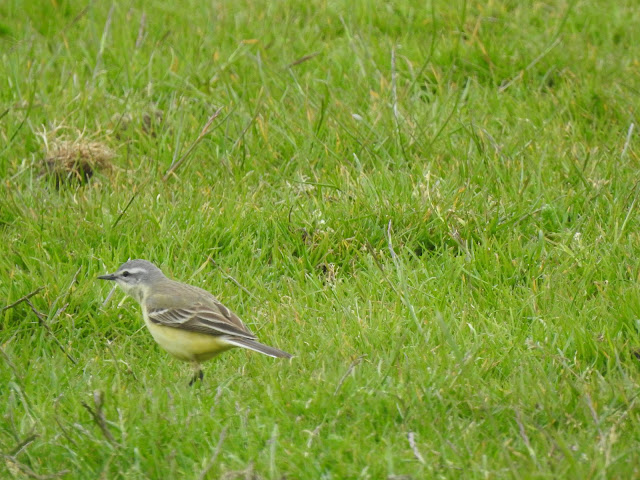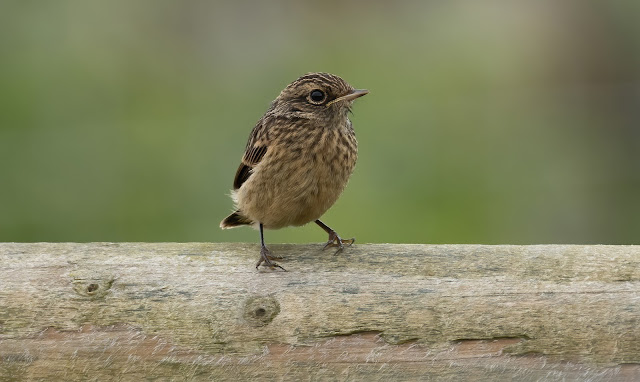Overcast for most of the week with multiple days with light rain. Max temperature of 17° on the 17th, average temperature was 13°. Light to moderate southwesterly winds all week.
A maximum count of 11 Mallard ducklings were seen in multiple broods on the 16th and 19th, which reduced down to just four on the 22nd. Two Shelduck flew high west over Benjamin’s Chair on the 18th. This is the third record for the year after none since 3rd May 2018. The bird of the week was an unlikely visitor. A female Mandarin duck was first seen by visiting Devon birders on Christie's Quay and later on Rat Island by Stuart Cossey, Jamie Dunning and Paul Holt. This constitutes the first record for the island. Mandarin ducks are originally from China and Japan but escaped captivity in the UK and are now common in Southern England.
 |
| Female Mandarin duck, Rat Island © Stuart Cossey |
Swift were seen on three dates with four on the 16th, six on the 19th and one on the 20th. Two different Cuckoo were recorded with a rufous brown individual on the Terrace on the 16th and another grey Cuckoo around Millcombe on the 20th. Collared Doves are still present with three by Big St. Johns on the 16th. A Collared Dove was ringed on the 20th in the Lodge Garden whilst trapping House Sparrows.
Some wader passage was logged with two Dunlin on Middle Park Pond on the 16th, a Curlew calling over the Landing Bay on the 17th and a Ringed Plover was heard over the Terrace on the 18th. Two Golden Plover were recorded both over the East Coast, one on the 16th and another on the 20th.
 |
| Dunlin, Middle Park Pond © Richard Campey |
Paul St Pierre and Anthony Bellamy from the RSPB were on the island this week to make counts of the breeding gull populations. The counts were split over several days with some colonies doing well and others not. Large numbers of adult Herring Gulls have been gathering in the fields around the Village during the week with a maximum count of 460 on the 22nd. A 2nd year Common Gull was seen in the Landing Bay on the morning of the 16th before drifting north.
Moving on to seabirds, the highest count of Puffins of the year so far was made on the 20th with 340 counted around Jenny’s Cove and surroundings. A walk around the whole island on the 19th by visiting birders Tim Jones and Tim Davis produced counts of 6901 Guillemot, 2237 Razorbills, 327 Kittiwakes, 108 Shag and 272 Fulmar. Two Cormorants were seen on the 17th and 19th.
The Kestrels are still being recorded with the male and female seen on the 16th and one or the other seen the rest of the week. Excellent numbers of Hobby have been seen during the week, three were recorded on the 16th and one on the 17th. A female / immature Marsh Harrier was seen over Tibbets before heading high towards the West Coast.
The resident Swallows have been seen regularly visiting the Church porch. A small camera has been set up to view the nest whilst on the island, though regular updates are being posted on the Lundy Island Facebook page. Other hirundines are still passing through with max counts on the 19th of nine Sand Martins 320 Swallows and 120 House Martins.
A Wood Warbler was still present on the 16th with one seen feeding in the Bracken on the Lower East Side. Small numbers of Willow Warbler and Chiffchaff have been seen throughout the week with a number singing in Millcombe, St Helens Copse and Quarter Wall Copse. Four Willow Warblers on the 21st was the highest count of the week. The highest count of Chiffchaff was seven on the 19th. Sedge Warblers are also still arriving with two on the 16th and 17th, three on the 18th, six on the 19th and singles on the 20th and 21st. Two Reed Warbler were reported on the 16th and singles of Garden Warbler were seen on the 16th, 17th and 19th. Resident male Blackcap and Whitethroat have been heard singing in and around Millcombe. The male Blackcap has a particularly varying call which includes a few harsh phrases and mimicry which at times resembles the song of a Marsh Warbler!
 |
| Whitethroat, Millcombe © Richard Campey |
Other migrants include a male Redstart on the 16th and 19th, a Black Redstart on the 21st and a female Whinchat on the 19th and 20th. Spotted Flycatchers have been recorded all week with high counts of 16 on the 16th and 20 on the 19th. A single Tree Pipit was reported on the 19th. Multiple Yellow Wagtails have been seen in Barton Field all week. Four on the 16th include three male Yellow Wagtails of the UK race flavissima and one Blue-headed flava Wagtail. Single Yellow Wagtails were seen on the 17th, 19th and 20th. On the 21st and 22nd two female flavissima and a new Blue-headed flava Wagtail were seen in Barton Field. Continental White Wagtails were recorded this week with singles on 16th and 22nd and two on 17th and 21st. Unfortunately, brief views of what was likely a Nightingale on the 20th were not enough to confirm the identification.
 |
| Blue-headed Wagtail, Barton Field, 16th May © Richard Campey |
 |
| Male Yellow Wagtail, Barton Field 16th May © Richard Campey |
 |
| Blue-headed Wagtail, Barton Field 22nd May © Stuart Cossey |
Signs of breeding include the first fledged Starlings, Blackbirds, Robins and Chaffinches. Multiple Stonechat pairs are now feeding fledged young and can be heard loudly ‘chacking’ as you walk past. The first Puffins have also been seen returning to burrows with fish, an excellent sign that the first chicks have hatched.
 |
| Starling with food, Barton Row © Richard Campey |
 |
| Juvenile Stonechat, Brick Field © Richard Campey |
In non-avian news a max count of 10 Painted Lady butterflies were counted on the 19th and 13 on the 20th. A Wall Brown was on the Upper East Side on the 21st. Brimestone, a scare Lundy species were seen on the 17th and 18th. Three Hummingbird Hawk-moth were reported on the 19th and a Striped Hawk-moth was reported on the 22nd. A Clouded Drab in the moth trap on the 18th was the first record for the island.
We also have a new arrival on the island with a foal born behind the Camping Field on the 20th.
 |
| New foal, Bull's Paradise © Stuart Cossey |
Contributors: S Cossey, R Ellis, Z Wait, L Pirateque, J Dunning, R Campey, T Davis, T Jones, P St Pierre, A Bellamy.
I did wonder why there were so many herring gulls over by the church and tavern today
ReplyDelete